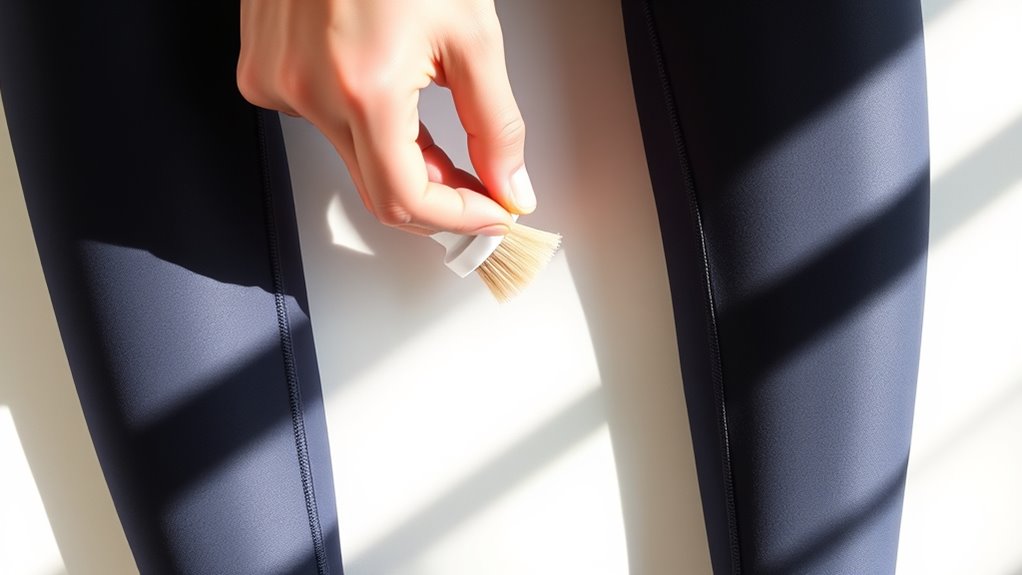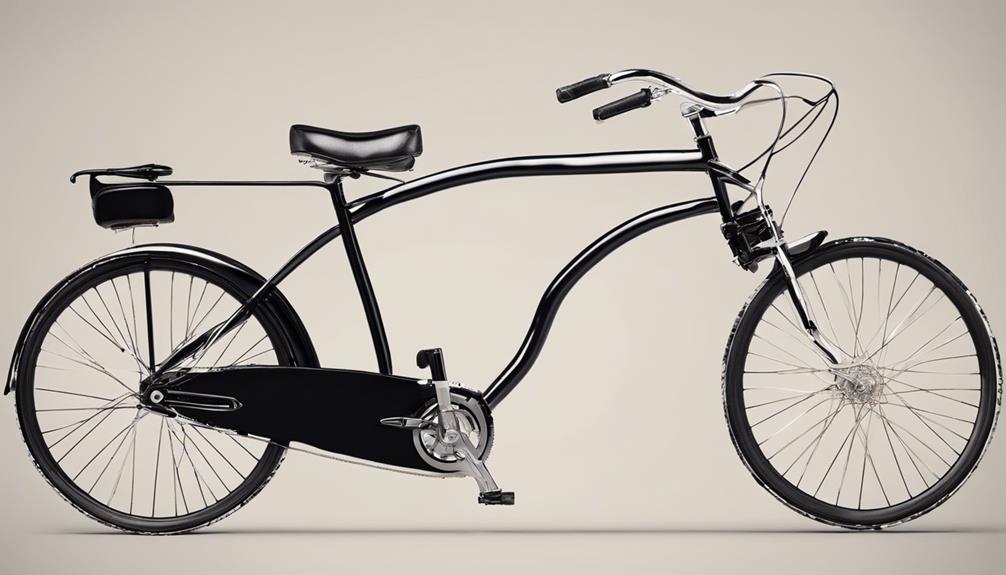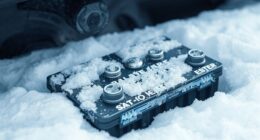To care for your performance apparel, wash inside out in cold water with mild detergent, avoiding fabric softeners and bleach. Air-dry on a rack away from direct sunlight to protect fabric and colors. For delicate or high-end items, opt for professional dry cleaning to preserve their quality. Keep footwear clean and dry, and take steps like airing out gear after workouts to prolong its life. If you want to learn more, keep going for expert tips and best practices.
Key Takeaways
- Wash activewear inside out in cold water with mild detergent to preserve elasticity and moisture-wicking properties.
- Air-dry garments flat or hanging inside out, avoiding direct sunlight and high heat to maintain fabric integrity.
- Avoid fabric softeners and bleach, which can damage delicate high-performance fabrics and reduce their effectiveness.
- Pre-treat stains with vinegar or baking soda before washing to extend garment lifespan and prevent odor buildup.
- For delicate or high-end items, opt for professional dry cleaning to ensure proper care and longevity.
Understanding the Unique Properties of High-Performance Fabrics
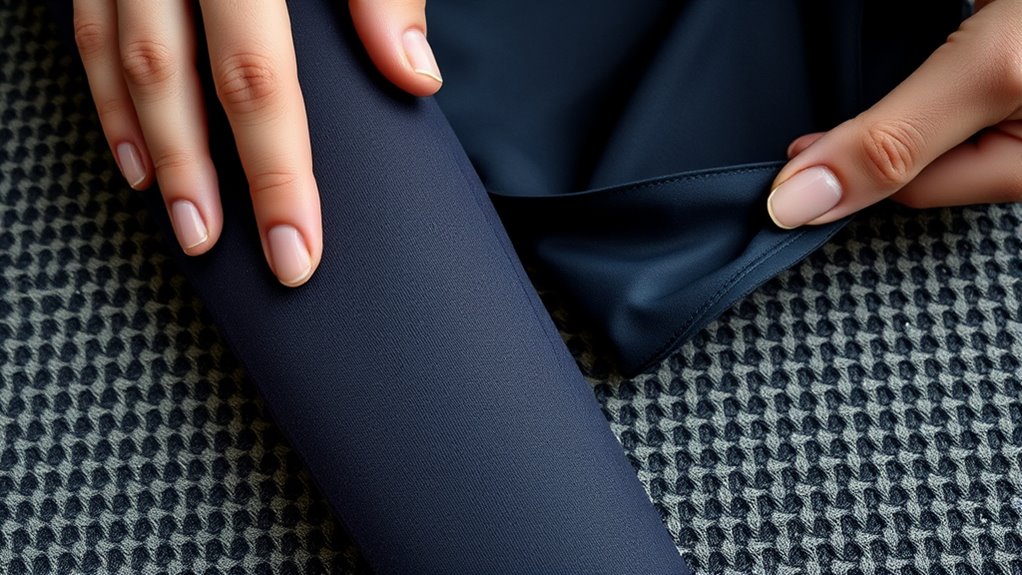
High-performance fabrics like polyester, nylon, and spandex are specially designed to enhance athletic performance by offering moisture-wicking, stretch, and durability. These technical fabrics feature micropores that promote breathability and moisture transfer, keeping you dry during intense activity. Their elasticity allows for freedom of movement, but it also means they’re sensitive to high heat, which can damage their fibers. You need to treat delicate fabrics gently to maintain their shape and performance. Harsh detergents and rough agitation can cause fading, peeling, or loss of elasticity. To preserve these properties, always use gentle cleaning methods and avoid high temperatures. Understanding these unique qualities helps you care for your performance apparel properly, ensuring it stays functional and vibrant over time. Proper fabric care and maintenance extend the lifespan of your gear and maintains its optimal performance, especially considering their specialized construction that enhances athletic function. Additionally, being aware of fabric sensitivities can help prevent accidental damage during laundering. Recognizing the horsepower of your gear can also guide you in selecting the right equipment for your needs, whether it’s for off-road adventures or everyday commuting.
Proper Washing Techniques for Activewear
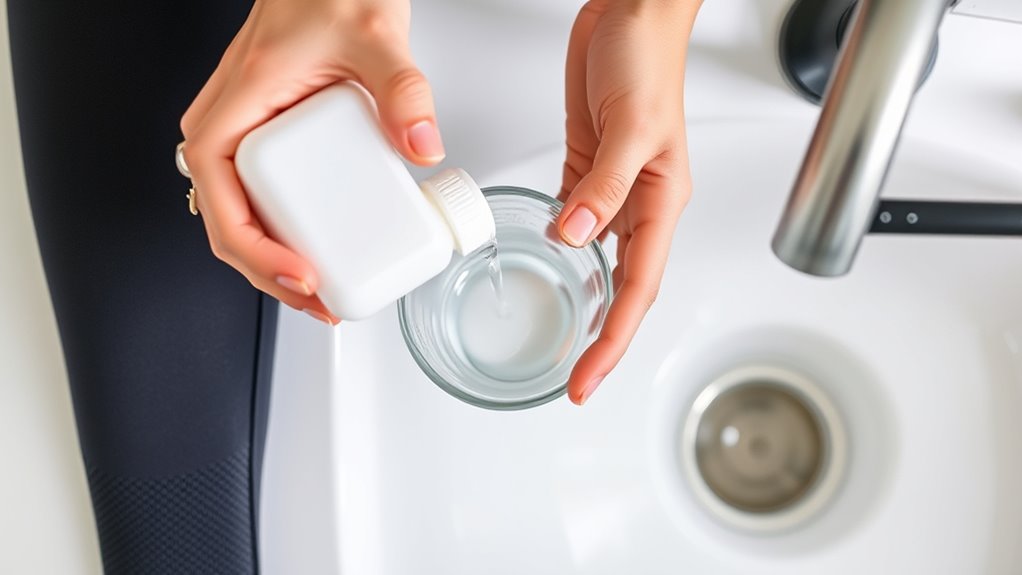
To preserve the quality and longevity of your activewear, it’s essential to follow proper washing techniques. Always turn your garments inside out before washing to protect logos, colors, and seams from friction and fading. Use cold water (below 40°C) and select a gentle cycle on your washing machine to prevent fabric damage, shrinking, and loss of elasticity. Apply a small amount of mild detergent, preferably powder, and avoid fabric softeners or bleach, as they can impair fabric performance. For heavily odoriferous or stained pieces, pre-soak in a vinegar-water solution for 20-30 minutes to eliminate odor-causing bacteria. After washing, air dry your activewear by hanging it inside out on a rack, avoiding direct sunlight and high heat, to maintain fabric integrity and elasticity. Engaging in virtual hackathons can also foster creative problem-solving skills that may translate into innovative approaches for fabric technology or sustainable materials in activewear. Additionally, understanding sound healing science can inspire new methods of designing calming environments that enhance recovery and relaxation after workouts. Incorporating knowledge about fiber technology can further improve the durability and performance of your activewear over time. Moreover, exploring Kia Tuning concepts such as suspension and material upgrades can provide inspiration for developing more durable and high-performance athletic fabrics.
Drying Methods to Preserve Fabric Integrity
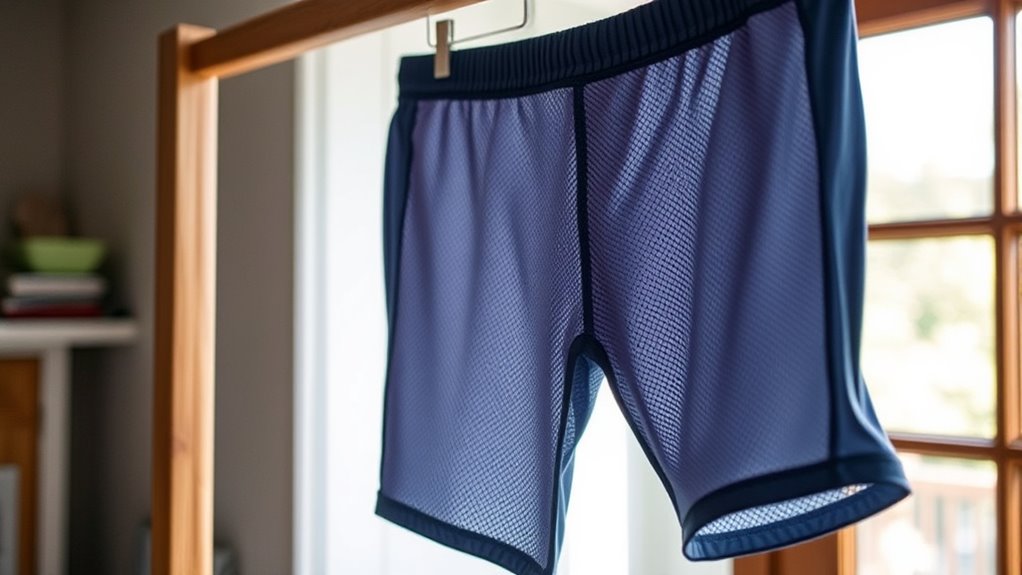
Drying your performance apparel properly helps preserve its fabric and elasticity. Air-drying on a flat or hanging rack is best, as it avoids heat damage and keeps colors vibrant. If you prefer using a dryer, set it to low heat and add dryer balls to protect your gear. Using durable materials designed for activewear can also extend the lifespan of your clothing. Additionally, avoiding excessive heat during drying prevents damage to sensitive components like electronic or Bluetooth features in some activewear. It’s also helpful to understand fabric care labels to ensure proper drying methods are followed. Regularly monitor your garments during the drying process to prevent overexposure to heat that could harm the fabric. Staying informed about technology integration in activewear can help you choose the best drying practices for garments with smart features.
Air-Drying Advantages
Air-drying offers a gentle and effective way to preserve the integrity of your performance apparel. By allowing moisture to escape naturally, air-drying maintains the fabric’s breathability and moisture-wicking properties, keeping your gear comfortable and functional. Hanging clothes inside out on a rack helps protect logos, colors, and delicate details from damage. This method minimizes the risk of fabric shrinking and elastic degradation caused by high heat, which can weaken fibers over time. Unlike tumble drying, air-drying reduces friction and heat exposure, preventing pilling and preserving elasticity. Using this method ensures your performance apparel retains its original fit, shape, and performance features, extending its lifespan. When you choose air-drying, you’re caring for your gear in a way that supports its fabric integrity and overall performance. Proper drying techniques also help maintain the clothing’s durability and appearance over time, especially by avoiding exposure to damaging high temperatures.
Proper Dryer Settings
Using the right dryer settings is essential to maintaining your performance apparel’s fabric quality. Always choose low heat, like the “air dry” or “fluff” setting, to prevent damage to performance fabrics. High heat can cause synthetic fibers, such as elastane and spandex, to shrink, lose elasticity, and weaken over time. Here are some tips:
- Use low heat or air dry on your dryer to avoid damaging performance fabrics.
- Only tumble dry if the manufacturer confirms it’s safe for your gear.
- Avoid high heat, which can fade colors and cause pilling.
- Remove clothes promptly and lay flat or hang to finish drying, preserving elasticity and moisture-wicking properties.
- Proper drying methods help prevent fabric deterioration and extend the lifespan of your workout clothes.
- Consulting your apparel’s performance fabric specifications can provide additional guidance on optimal drying conditions.
- Understanding fabric care instructions can help you select the proper drying settings to keep your gear in top condition and prevent unnecessary wear and tear.
Common Mistakes to Avoid in Activewear Maintenance
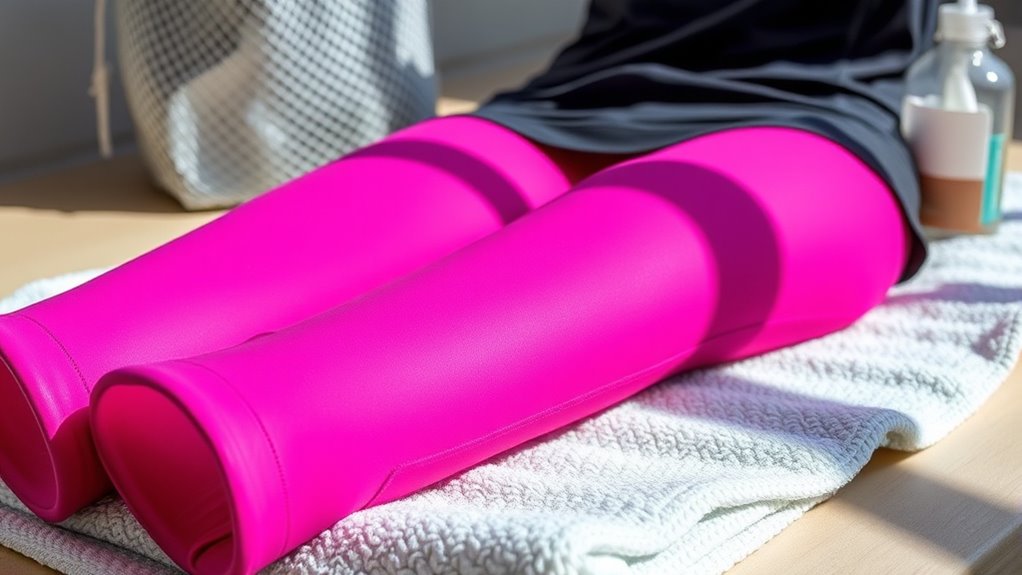
To keep your activewear in top shape, it’s essential to avoid common maintenance mistakes that can damage the fabrics and reduce their performance. Using harsh detergents can weaken fibers, so stick to gentle, sports-specific cleaners. Always turn your garments inside out before washing to protect logos and details from pilling and fading. Washing high-performance fabrics in hot water or drying at high heat can cause shrinking, loss of elasticity, and fabric damage—use cold or warm water instead. Avoid overloading your washing machine, which prevents proper cleaning and strains delicate fabrics. Also, steer clear of fabric softeners, as they clog fibers and hinder moisture-wicking. Proper care, including gentle washing and air-drying, helps preserve the longevity and performance of your activewear.
When to Choose Professional Dry Cleaning Services
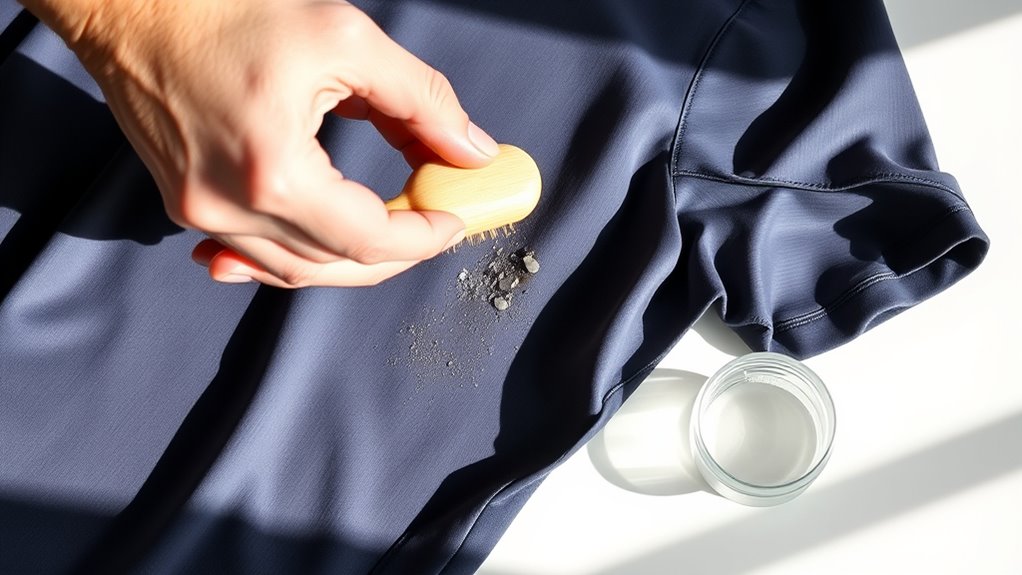
If your activewear includes delicate fabrics like cashmere, satin, or high-tech materials, it’s time to contemplate professional dry cleaning. These garments need special care to maintain their elasticity, color, and texture, which home washing can damage. When your clothes have intricate details or embellishments, dry cleaning helps prevent peeling or fraying, ensuring they stay in top condition.
Delicate Fabric Preservation
When caring for delicate fabrics like cashmere-blend activewear, wool coats, or satin leggings, professional dry cleaning is often the best choice to preserve their quality. Home washing can risk fabric damage and reduce lifespan. Consider dry cleaning if you want to:
- Protect high-performance fabrics from water, heat, and agitation that cause deterioration.
- Maintain the texture, elasticity, and appearance through specialized cleaning methods.
- Prevent pilling, shrinking, or weakening caused by improper washing.
- Achieve fabric preservation and lifespan extension with expert techniques.
Professional cleaning uses specialized solvents and methods that are gentler on sensitive materials. For delicate fabrics, dry cleaning ensures your performance apparel stays in superior condition, prolonging their usability and look.
Optimal for High-End Garments
High-end garments like cashmere blends, wool, satin, and specialized technical fabrics demand professional dry cleaning to keep them in pristine condition. These delicate garments require expert care to maintain their fabric preservation, elasticity, and vibrant colors. Home washing methods can cause shrinkage, warping, or fabric deterioration, risking damage to high-performance fabrics and delicate garments. Dry cleaning uses gentle solvent cleaning that effectively removes dirt, sweat, and oils without water or agitation, ensuring proper garment care. When you want to extend your garment’s longevity and preserve intricate details or sensitive finishes, professional dry cleaning is the best choice. For busy schedules, same-day dry cleaning with pickup and delivery is available in Arlington, VA, offering convenient, timely service for your high-end wardrobe.
Maintaining Footwear and Gear for Optimal Performance
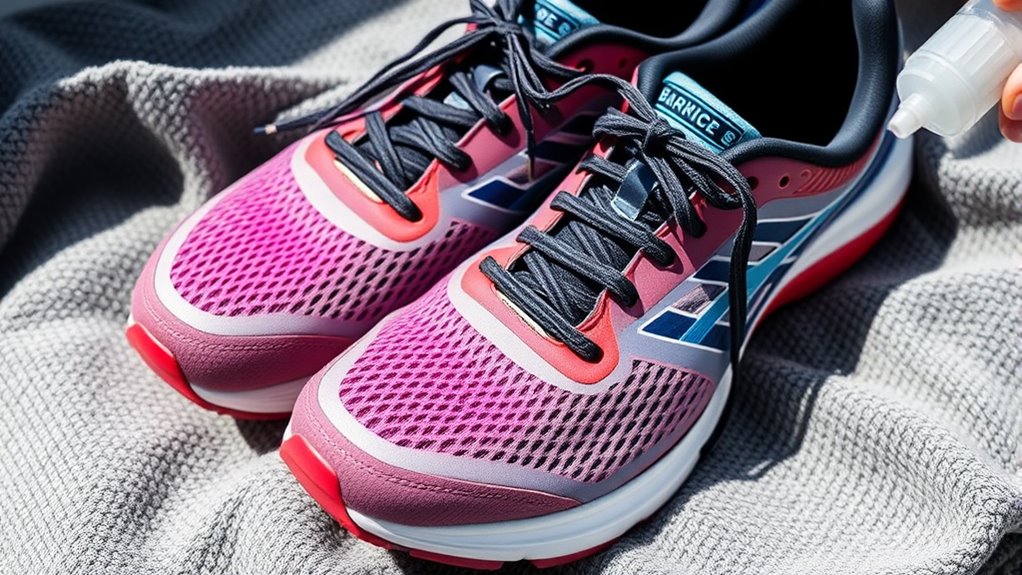
Ever wonder how proper footwear maintenance can boost your athletic performance? Keeping your athletic shoes in top shape ensures they perform their best. Here’s how:
- Clean your shoes regularly with a mild solution and let them air dry to reduce bacteria buildup and odor retention.
- Remove insoles and liners after each use to improve ventilation and prevent bacteria growth inside.
- Apply waterproofing sprays periodically to maintain moisture resistance, especially in wet conditions.
- Use boot dryers or absorbent powders to thoroughly dry shoes, preventing mold and bacteria formation.
Storing your footwear in a cool, ventilated area away from direct sunlight preserves the materials and extends their lifespan. Proper care keeps your gear performing at its peak.
Tips for Extending the Lifespan of Your Athletic Apparel
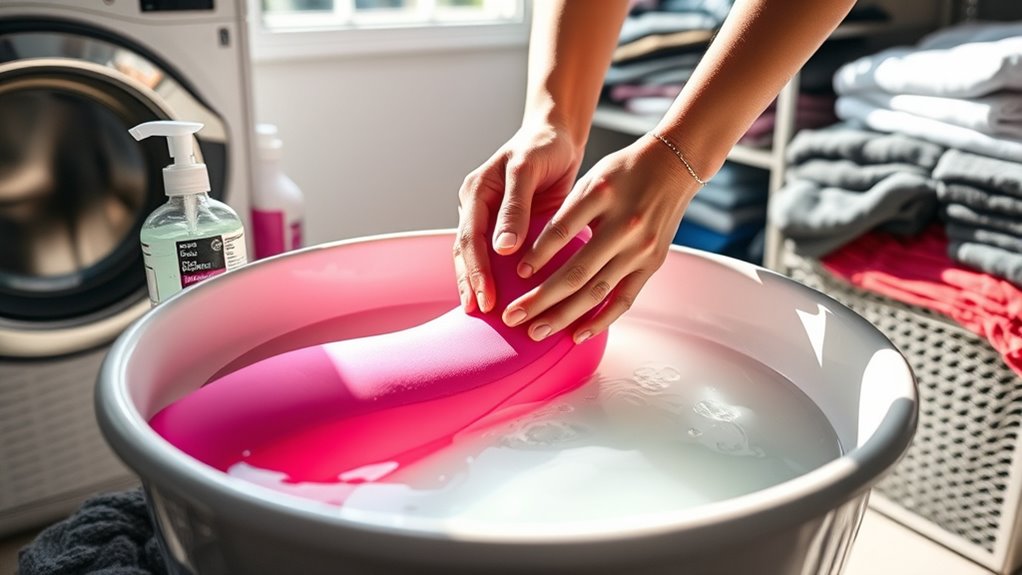
Proper maintenance of your athletic apparel not only keeps it looking vibrant but also extends its functional lifespan. To achieve this, focus on fabric care by washing inside out in cold water to preserve elasticity and colors. Avoid fabric softener and bleach, as they can damage moisture-wicking fibers. Pre-treat stains with gentle solutions like vinegar or baking soda before washing. Limit wash frequency by airing out gear after workouts, which helps extend lifespan. For drying, air-drying prevents heat damage and maintains fabric integrity. Follow these tips consistently to keep your performance apparel in top shape.
| Fabric Care Tip | Action | Benefit |
|---|---|---|
| Pre-treat stains | Use vinegar or baking soda | Reduce wear from repeats |
| Water temperature | Wash in cold water | Preserve fabric elasticity |
| Drying method | Air-dry instead of machine drying | Avoid heat damage |
Frequently Asked Questions
How Often Should I Replace My Activewear for Optimal Performance?
You might wonder how often to replace your activewear for top performance. Typically, you should swap out your gear every 6 to 12 months, especially if you notice signs of wear like thinning fabric, loss of elasticity, or persistent odors. Regularly inspecting your apparel helps guarantee you get the best support and comfort during workouts. Don’t wait too long—replacing worn-out pieces keeps your performance ideal and your workouts enjoyable.
Can I Use Regular Detergent on High-Performance Fabrics?
You might wonder if regular detergent works on high-performance fabrics. While it’s tempting, using regular detergent can leave residues that break down the fabric’s moisture-wicking and breathability. Instead, opt for a gentle, sports-specific detergent that’s designed to preserve your apparel’s tech features. This way, you’ll keep your gear in top shape, ensuring it performs best and lasts longer without damaging the fabric.
What Are Signs My Activewear Needs Professional Cleaning?
You might think your activewear’s indestructible, but signs it needs professional cleaning are subtle. If your workout clothes start smelling even after washing, or if stains stubbornly linger, it’s time to call in the pros. Over time, sweat and oils can break down fabrics, reducing their effectiveness. Ignoring these signs could mean sacrificing performance, so trust expert cleaning when your gear shows the first hints of needing a little extra care.
How Do I Prevent Odor Buildup in My Workout Clothes?
To prevent odor buildup in your workout clothes, you should wash them promptly after each use to remove sweat and bacteria. Use a mixture of water and white vinegar or a specialized sports detergent to break down odors. Avoid fabric softeners, as they can trap smells. Always let your clothes dry completely before storing. Regularly wash your gym bag and avoid leaving damp clothes inside for too long.
Is It Safe to Iron or Press Performance Apparel?
You might wonder if ironing or pressing your performance apparel is safe. Generally, it’s best to avoid high heat, as it can damage fabrics like spandex or moisture-wicking materials. If you must, use a low heat setting and place a cloth between the iron and your clothing. Always check the care label first, and consider alternative methods like steaming to smooth out wrinkles safely.
Conclusion
By mastering mindful maintenance, you’ll maximize your gear’s lifespan and performance. Remember to wash wisely, dry delicately, and avoid common mistakes that may compromise your apparel. When in doubt, don’t hesitate to seek professional service. Keep your kicks, clothes, and gear in great shape, and enjoy peak output every time you train. Properly caring for your performance apparel isn’t just maintenance; it’s the secret to sustained success and stellar sport.
